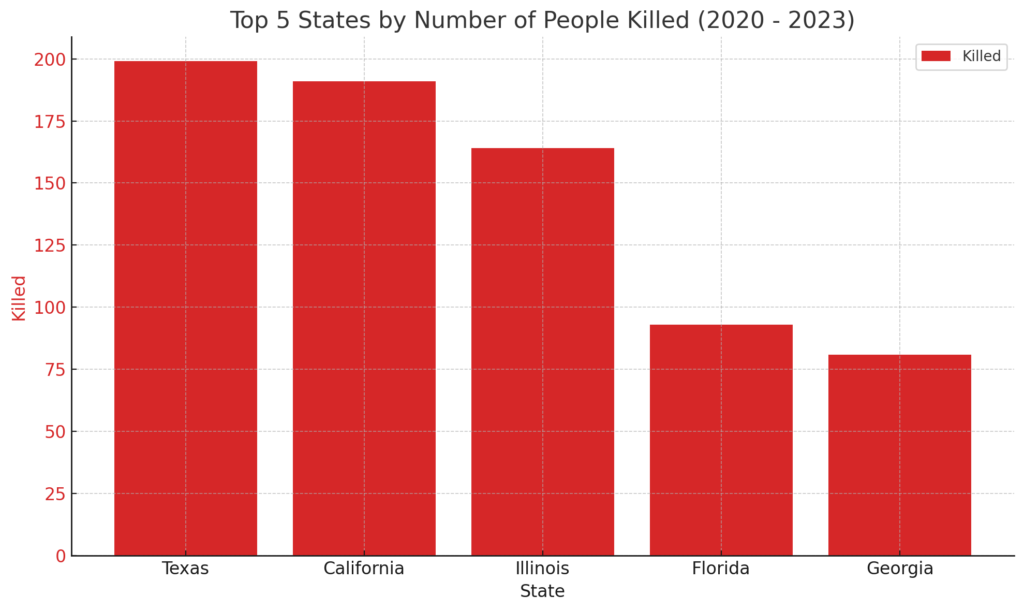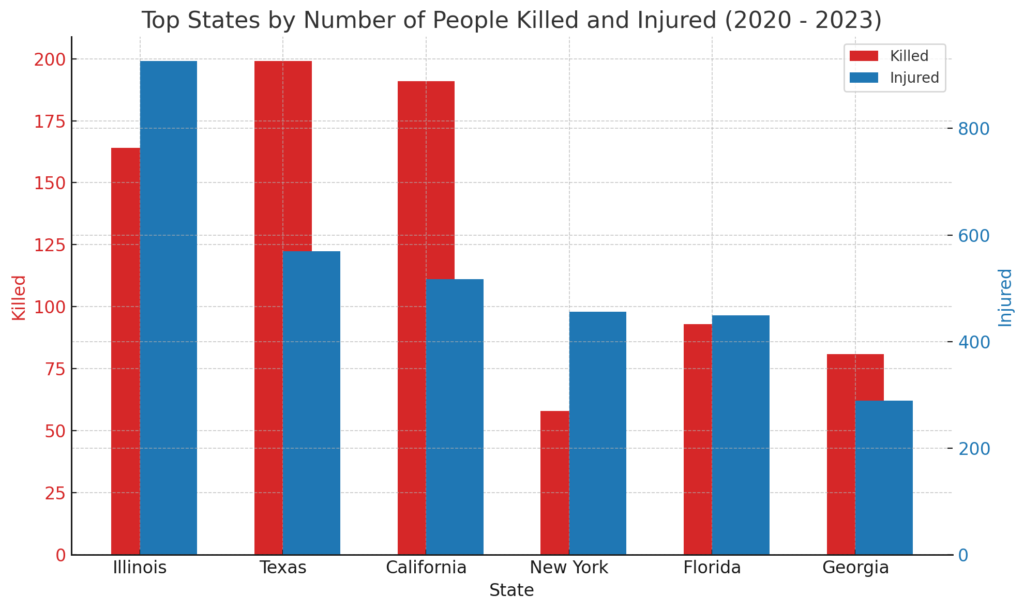
In the United States, gun violence remains a pervasive issue, casting long shadows over communities, cities, and states. From the heart-wrenching stories of mass shootings to the daily incidents that fail to make national headlines, the human cost of this violence is staggering. As debates over gun control and violence prevention continue, it is crucial to ground these discussions in data to understand the scale and impact of the issue fully.
This blog post aims to shed light on the extent of gun violence across the United States, focusing on the total number of injuries and deaths resulting from these incidents between May 2020 – April 2023. Through the lens of a comprehensive heatmap visualization, I’ll look into the geographical distribution of gun violence, identifying patterns and hotspots that reveal the states most affected by this crisis.
By analyzing data on gun violence incidents, this post will highlight the top five states with the highest numbers of deaths and injuries, providing insights into the scale of the issue in different regions.
Texas, California, Illinois, Florida, and Georgia emerge as the states with the most fatalities, while a different picture is painted for injuries, with Illinois leading, followed by Texas, California, New York, and Florida.
Let’s take a closer look at the factors contributing to the high rates of gun violence in these states and discussing potential policy responses and preventive measures. Through this analysis, I aim to contribute to the ongoing conversation about gun violence in the U.S., emphasizing the need for informed action to address this critical issue.
Understanding the Data
NOTE: The map is interactive!
To interact with the map, zoom in and out using your mouse wheel or trackpad, and click and drag to move the map around.
The foundation of any meaningful discussion on gun violence lies in the data which highlights the issue’s scope and impact. For this analysis, I’ve drawn on datasets from the Gun Violence Archive website that track gun violence incidents across the United States, including both fatalities and injuries. My goal is to present a clear visual representation of the data, to identify trends and hotspots of violence at a glance.
Insights
The heatmap reveals several key insights:
- Geographical Variability: Gun violence is not evenly distributed across the United States. Certain regions and states stand out as hotspots, indicating higher concentrations of incidents.
- Urban vs. Rural Divide: The visualization suggests a pattern where urban areas tend to have higher incidences of gun violence, a reflection of various socio-economic factors.
- State-Specific Trends: Some states consistently show up as areas of high intensity for both injuries and fatalities, pointing to systemic issues that may be unique to those regions.
These observations set the stage for a deeper investigation into the states most affected by gun violence. By understanding where and how these incidents cluster, we can begin to dissect the complex factors at play and consider effective strategies for prevention and response.
The Deadliest States for Gun Violence

The heatmap visualization of gun violence across the United States has led us to identify the states where the grim tally of deaths is highest. Let’s examine the statistics that mark Texas, California, Illinois, Florida, and Georgia as the states bearing the brunt of gun violence fatalities. Understanding the scale of loss in these regions is crucial for any discussion on national and local policy reforms aimed at curtailing gun-related deaths.
1. Texas: A Complex Tapestry of Gun Culture
Leading the list with a staggering 199 fatalities, Texas exemplifies the intricate relationship between gun rights advocacy, legislative frameworks, and public safety challenges. The state’s robust gun culture, combined with its vast size and significant urban-rural divide, contributes to its high incidence of gun-related deaths. Analyzing Texas’ situation requires a careful consideration of its socio-political context, including its legislation on gun ownership and the efforts to balance individual rights with community safety.
2. California: Contrasts and Challenges
Despite having some of the strictest gun control laws in the nation, California follows closely with 191 fatalities. This paradox highlights the state’s vast disparities in income, urbanization, and social issues, underscoring the fact that legislation alone cannot address the root causes of gun violence. The state’s struggle against gun-related deaths points to the need for extensive policies that include community engagement, mental health support, and socioeconomic development.
3. Illinois: The Shadow of Urban Violence
Illinois, with 164 fatalities, illustrates the acute impact of gun violence in urban centers, particularly in Chicago. The city’s struggle with gang violence, economic disenfranchisement, and racial disparities offers a microcosm of the broader challenges facing the state. Illinois’ experience emphasizes the importance of targeted interventions that address the underlying social determinants of gun violence, alongside legislative measures.
4. Florida: The Pulse of Gun Violence
With 93 fatalities, Florida’s experience with gun violence includes high-profile mass shootings that have sparked national debates on gun control, mental health, and the security of public spaces. The state’s diverse population and prominent tourist industry add layers of complexity to addressing gun violence, suggesting the need for policies that enhance public safety while respecting the rights of lawful gun owners.
5. Georgia: Rural Realities and Urban Issues
Georgia rounds out the top five with 81 fatalities, reflecting a blend of urban and rural gun violence challenges. The state’s experience points to the varied nature of gun violence, from domestic incidents in rural areas to street violence in cities like Atlanta. Addressing Georgia’s gun violence requires a multifaceted approach that considers the diverse settings and circumstances in which these events occur.
The high death tolls in these states paint a sobering picture of the human cost of gun violence in America. As we reflect on these numbers, it’s imperative to consider the stories and lives behind the statistics, guiding our pursuit of solutions that can prevent future loss. Now let’s explore the states with the highest number of injuries from gun violence, adding another dimension to our understanding of its impact.
Where Injuries from Gun Violence Prevail

While fatalities paint a stark picture of gun violence’s ultimate toll, injuries represent the broader, often ongoing, impact on communities and individuals. Surviving a gun violence incident can lead to a lifetime of physical and psychological challenges, underscoring the need to address not just the mortality but also the morbidity associated with these shootings. Here we have the states with the highest numbers of injuries from gun violence, offering insight into the scale of suffering that goes beyond the loss of life.
1. Illinois: A Persistent Struggle Against Violence
Topping the list with an astonishing 926 injuries, Illinois, particularly through its urban center, Chicago, faces a severe challenge in curbing gun violence. The high number of injuries reflects not only the frequency of gun-related incidents but also the profound impact on community health resources, emergency response systems, and long-term rehabilitation services. Illinois’ struggle underscores the importance of comprehensive strategies that include community-led violence prevention programs, improved access to mental health care, and socioeconomic initiatives aimed at addressing the root causes of violence.
2. Texas: The Broad Scope of Gun Violence
Following Illinois, Texas reports 569 injuries, illustrating the widespread nature of gun violence across the state. From domestic disputes to public shootings, the variety of incidents contributing to this number highlights the complex interplay of factors driving gun violence. Addressing this issue in Texas demands a nuanced understanding of the state’s diverse communities and a concerted effort to promote gun safety, responsible ownership, and effective law enforcement strategies.
3. California: Injuries Amidst Stringent Laws
Despite having stringent gun control measures, California sees 517 injuries from gun violence, suggesting that legislative efforts must be part of a broader strategy. The state’s injuries highlight the challenges of urban violence, the impact of illegal firearms, and the need for community-based interventions that can work alongside regulatory measures to reduce violence effectively.
4. New York: Urban Density and Gun Injuries
With 456 injuries, New York’s experience with gun violence reflects its urban density and the complexities of policing and community safety in crowded environments. Efforts in New York emphasize the importance of targeted law enforcement initiatives, gun trafficking interdiction, and programs that engage at-risk youth in positive community-building activities to reduce the likelihood of violence.
5. Florida: The Intersection of Legislation and Public Health
Florida, recording 449 injuries, stands at the intersection of gun legislation debates and public health concerns. Initiatives such as enhanced background checks, safe storage laws, and public awareness campaigns about gun safety could play pivotal roles in reducing both fatalities and injuries.
The significant number of injuries in these states not only represents immediate trauma but also the long-term consequences for survivors, families, and communities. The prevalence of injuries underscores the need for a comprehensive public health approach to gun violence, one that includes prevention, immediate intervention, and ongoing support for those affected. In the following section, we will compare the states with high death rates to those with high injury rates, seeking to understand the broader implications for policy and community action.
A Comparative Analysis
In the pursuit of understanding the full impact of gun violence, it is crucial to consider both the fatalities and injuries within the most affected states. This comparative analysis seeks to identify patterns, differences, and insights that emerge when juxtaposing states with the highest numbers of deaths against those with the most injuries. Such an examination can illuminate the multifaceted nature of gun violence and highlight the efficacy of various policy responses and preventive measures.

Comparing Fatalities and Injuries
A striking observation from our analysis is the recurrence of certain states across both lists, namely Texas, California, Illinois, and Florida. This overlap suggests that regions with high fatalities from gun violence also tend to experience a significant number of injuries, indicating pervasive issues that affect a broad spectrum of the population. In contrast, Georgia’s presence among the top states for fatalities, but not injuries, alongside New York’s opposite scenario, prompts a deeper investigation into the specific dynamics and responses at play within these states.
Trends and Insights
- Urban vs. Rural Impact: Illinois, particularly Chicago, exemplifies how urban settings with concentrated populations can experience high levels of both fatalities and injuries. In contrast, states with a mix of urban and rural areas, like Texas and California, show that gun violence is not confined to cities alone but is a widespread issue requiring diverse strategies.
- Effectiveness of Legislation: California and New York, known for their strict gun laws, still face high injury rates, suggesting that legislation, while crucial, must be part of a holistic approach that includes community engagement, education, and economic development.
- Socio-economic Factors: The data underscores the influence of socio-economic factors on gun violence. States with high levels of economic disparity, unemployment, and limited access to education and healthcare services tend to have higher rates of both fatalities and injuries, highlighting the need for comprehensive socio-economic policies.
Policy Implications
The analysis points to the necessity for multi-faceted policy approaches that go beyond gun control laws. Effective strategies may include:
- Enhanced Community Policing: Building trust between law enforcement and communities to prevent violence before it occurs.
- Mental Health and Social Services: Expanding access to mental health care and social services to address underlying issues that lead to violence.
- Education and Economic Opportunities: Investing in education and economic development to reduce the socio-economic disparities that often correlate with higher rates of violence.
The Role of Public Awareness and Education
Raising public awareness about gun safety, the impact of gun violence on communities, and the importance of responsible gun ownership is critical. Educational campaigns can play a vital role in changing attitudes and behaviors related to gun use and storage.
This comparative analysis highlights the complexity of addressing gun violence in the United States. By examining both fatalities and injuries, we gain a more comprehensive understanding of the issue’s scope and the multi-dimensional efforts needed to reduce violence. The insights derived underscore the importance of tailored, community-specific responses alongside broader legislative and policy measures.
The Way Forward
The insights gleaned from analyzing the states most affected by gun violence, both in terms of fatalities and injuries, illuminate the path towards a safer future. The human cost of this endemic issue compels us to seek out and implement solutions that address the root causes and immediate impacts of gun violence. Let’s look at potential next steps, advocating for a holistic approach that combines policy reform, community engagement, and public health initiatives.
Policy Reform
Legislative action remains a cornerstone of the effort to reduce gun violence. Policies that focus on background checks, restrictions on high-capacity magazines, and regulations for gun sales can create barriers to the illegal or unsafe use of firearms. However, as seen in states with stringent laws yet high injury rates, policy reform must be part of a broader strategy that addresses the socio-economic factors contributing to violence.
Community Engagement and Empowerment
Empowering communities to lead the charge in violence prevention is critical. Local programs that engage youth, support families in crisis, and offer alternatives to violence can have a profound impact. Initiatives such as community-based violence interruption programs have shown promise in reducing shootings and homicides by mediating conflicts and providing support to those at risk of engaging in gun violence.
Mental Health Support
Expanding access to mental health services can address one of the root causes of violence. By providing support for individuals struggling with mental health issues, we can prevent some of the circumstances that lead to gun violence. This includes not only treatment but also early intervention programs in schools and communities.
Education and Economic Opportunities
Addressing the socio-economic disparities that underlie much of the violence is essential. Improving education access, job training, and economic opportunities in underserved communities can reduce the allure of gangs and violence as a means of achieving status or financial security.
Raising Awareness
Public awareness campaigns about gun safety and the consequences of gun violence can change hearts and minds. By promoting responsible gun ownership and highlighting the human stories behind the statistics, we can foster a culture that values life and prioritizes safety.
A Call to Action
The journey towards reducing gun violence is a collective endeavor that requires the involvement of policymakers, community leaders, healthcare professionals, educators, and citizens. It is a call to action for all of us to participate in creating safer communities through informed dialogue, advocacy, and persistent efforts at every level of society.
Conclusion
The data on gun violence fatalities and injuries in the United States paints a sobering picture, but it also provides a roadmap for change. By understanding the complexities of the issue and embracing a multi-dimensional approach, we can work towards a world where such violence is significantly reduced. Let this analysis serve as a foundation for ongoing discussions, policy formulations, and community efforts to address one of the most pressing issues of our time.
Problem Statement: “ To visualize injuries and deaths from gun violence in the U.S. from May 2020 – April 2023.”
Skills Used:
- Data cleaning and preprocessing
- Geocoding addresses to get latitude and longitude coordinates
- Visualizing geographic data using Folium library
- Creating interactive heatmap
- Filtering and selecting specific data based on certain criteria
- Exporting maps to HTML files or embedding them in web pages or other applications
- Working with large datasets and optimizing code for performance